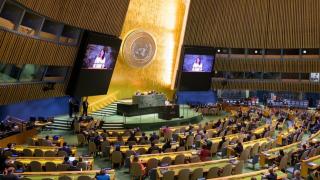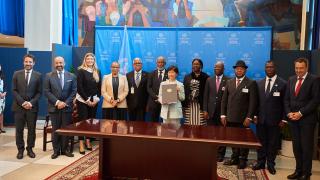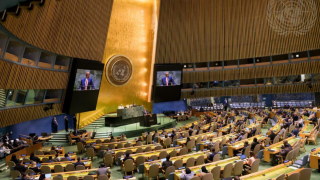
Part of our regular series of background briefings on the UN in the news.
Two years ago the UN General Assembly held a high-level summit "to address large movements of refugees and migrants". The resulting New York Declaration set out member states' resolve to start negotiations on a new global compact on "safe, orderly and regular migration".
In the intervening time every single UN member state - with the exception of the USA which withdrew from negotiations in December 2017 - worked on the development of a final text, which will now be adopted at a conference in Marrakech, Morocco on the 10-11 December.
In light of the discussion that this has inspired, and to correct any misconceptions, we have prepared the following briefing.
What is the state of migration globally?
- There are 257.7 million international migrants - around 3.5% of the world's population
- Of those 25.4 million are refugees and 3.1 million are asylum seekers (refugees whose application is awaiting processing), the vast majority hosted in developing countries
- 157 million migrants live in high income countries
- It is hard to quantify the scale of "irregular" migration, but it is estimated that, for example, across the European Union there are between 2 and 8 million irregular migrants, and 40 million regular migrants, suggesting that irregluar migration represents a small fraction of the total
- Irregular migrants face significant risks. The Missing Migrant project has tracked over 3,300 migrant deaths so far this year, and many more may never be recorded
What is the Global Compact on Migration?
The global compact is a non-legally binding political declaration. It is similar to the communiques which are typically agreed at the end of conferences. It is not a treaty or a resolution, but simply a shared commitment to the ideas expressed within it.
While on its own the global compact does nothing more than affirm that states believe a certain set of things, the final section of the compact does suggest a mechanism for implementation, in the form of "enhanced bilateral, regional and multilateral cooperation" and "a capacity-building mechanism in the United Nations." Technically these are only suggestions, and it will be for the United Nations General Assembly to establish such a mechanism and resource it, by passing a resolution. However, if the compact is widely adopted then the passage of such a resolution is likely to be a formality.
What does the Global Compact on Migration do?
The compact affirms that migration is an issue which is best managed on a collective basis, and that migration should be safe, orderly and regular. It:
"recognizes that a comprehensive approach is needed to optimize the overall benefits of migration, while addressing risks and challenges for individuals and communities in countries of origin, transit and destination. No country can address the challenges and opportunities of this global phenomenon on its own."
To this end it endorses a set of ten "cross-cutting and interdependent guiding principles" which give rise to 23 objectives. The majority of the 31 page long, 17 000 word text expands upon and clarifies these objectives. In summary the text:
- calls for better data gathering and data sharing so that migration can be better understood, monitored and managed
- aims to prevent exploitation and hardship in migration, as a consequence of migration or which might cause forced migration
- demands protection of the human rights of migrants and those whose lives are affected by migration
- supports cultural and economic inclusion including through endorsing the ideas of faster remittances payments, social cohesion, portability of social security entitlements, the development and recognition of skills and evidence-based public discourse
Does the compact endorse open borders?
Far from it, the purpose of the compact is to "facilitate and ensure safe, orderly and regular migration" and to this end the compact urges states to "manage borders in an integrated, secure and coordinated manner" and "to increase legal certainty and predictability of migration procedures".
Indeed, the language of the compact is ambivalent in its support for migration. On the one hand states "recognize that [migration] is a source of prosperity, innovation and sustainable development in our globalized world", but on the other the compact "seeks to address the legitimate [sic] concerns of states and communities, while recognizing that societies are undergoing demographic, economic, social and environmental changes at different scales that may have implications for and result from migration". There is a clear factual argument to be made that migration is a force for good in the world; the World Bank calls migration "the most effective way to reduce poverty and share prosperity". Yet the compact shies away from making this argument.
Contrary to some coverage, the compact does not make migration a human right, or even suggest that it should become one. It reaffirms existing human rights law and that "migrants are entitled to the same universal human rights and fundamental freedoms" as everybody else, but it makes no claim that there is a right to migrate, or indeed that any new human rights should be recognised. Nor does it criminalise criticism of migration, as some commentators have claimed. The compact calls on states "to eliminate all forms of discrimination ... against all migrants" and suggests that one way in which this could be achieved (listed among seven options that states might wish to "draw from") would be to "enact, implement or maintain legislation that penalizes hate crimes and aggravated hate crimes targeting migrants".
Who will sign?
While 192 countries agreed to the draft text when it was finalised back in September, a number of states have subsequently had second thoughts. Louise Arbour, the UN Special Representative for International Migration, has criticised these countries (which, at the time of writing, include Austria, Australia, Bulgaria, Croatia, the Czech Republic, Hungary, Italy, Israel, Poland, Slovakia and Switzerland) pointing out that it "reflects very poorly" on states to withdraw from endorsing a text which they themselves have negotiated. In Slovakia, the refusal of the government to sign resulted in the resignation of the Foreign Minister, Miroslav Lajčák, who in his former role as President of the United Nations General Assembly had played an important role in the compact's genesis. In Belgium a partner in the ruling coalition has threatened to bring down the government if officials attend the conference.
These last-minute withdrawals, much like the compact itself, have largely symbolic value. Those that sign declare their commitment to the ideas contained in the document, those who are not committed to those ideas would achieve little by signing in any case. The vast majority of the world's nations are expected to sign; outlier nations will succeed in signalling to domestic constituencies that they are uninterested in working with the rest of the world on this issue but will then find themselves outside the mechanisms of support and burden-sharing that such cooperation could bring.
Is this an adequate response to the issue of irregular migration?
The objectives of the compact are modest, and its language is highly caveated; as a consequence the direct impact of the compact is likely to be limited. In the context of the thousands of migrants that are killed every year, the vast majority of them crossing the Mediterranean, it is legitimate to ask if this response is sufficient. This is particularly true given that irreversible climate change is likely to force many millions more migrants to leave their homes in the decades to come.
Nevertheless, the compact represents a collective acknowlegement by the vast majority of the world's nations that issues relating to migration are global, and that individual nation states cannot hope to address them alone. It further provides a mechanism for more effective cooperation to that end. Furthermore, the migration compact does not operate alone, but sits alongside a "global compact on refugees". This second compact has, perhaps surprisingly, attracted much less controversy and secured the engagement of all the world's nations (including the United States). It looks set to be adopted by the UN General Assembly by the end of the year.
Photo: staff of the IOM in Indonesia hold a vigil for migrants who have lost their lives in search of a safe haven. Credit IOM






